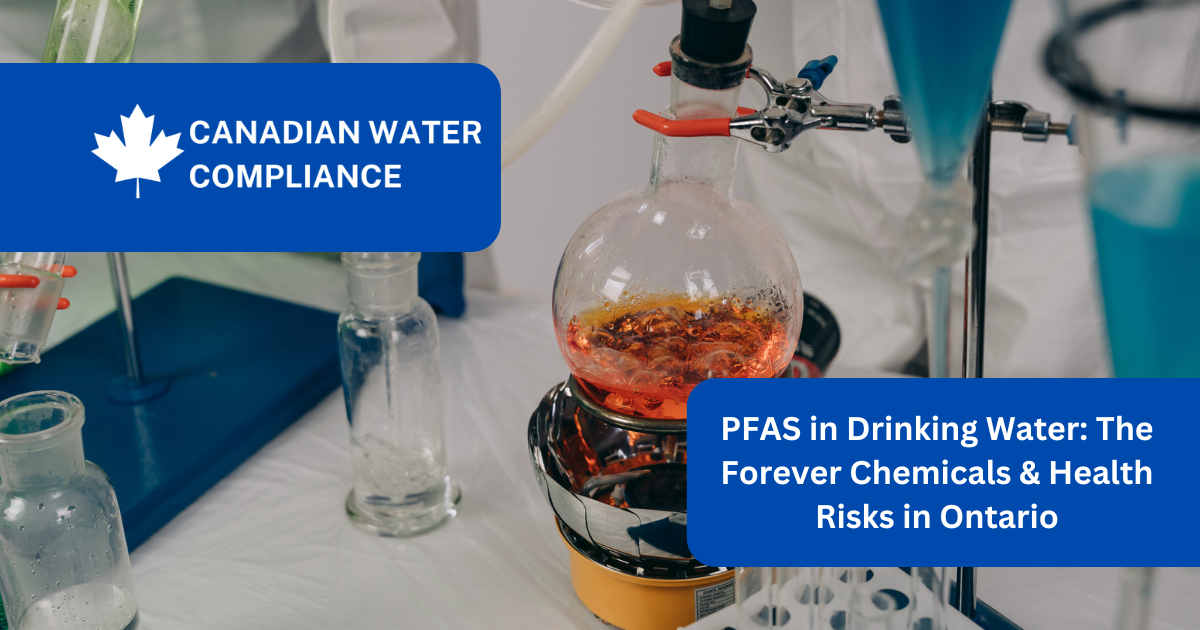
Written By: Canadian Water Compliance | On
PFAS, or Per- and Polyfluoroalkyl Substances, are a group of human-made chemicals used in industrial applications, firefighting foams, non-stick cookware, and water-resistant materials. Known as “forever chemicals”, PFAS do not break down easily and have been detected in drinking water supplies across North America—including Ontario.
Studies link PFAS exposure to cancer, liver damage, immune system disruption, and developmental issues. In response, governments are setting stricter limits on PFAS in drinking water, but challenges remain in testing, removal, and long-term mitigation.
PFAS were developed in the 1940s and became widely used due to their waterproof, grease-resistant, and heat-resistant properties. Over time, they have made their way into the environment, contaminating water supplies, soil, and even food.
🚰 How do PFAS enter drinking water?
Industrial runoff from manufacturing plants
Firefighting foams used at airports and military bases
Landfills & wastewater treatment plants
Household products such as stain-resistant fabrics and non-stick cookware
Research has linked long-term PFAS exposure to:
⚠️ Increased cancer risk (kidney, testicular)
⚠️ Liver and thyroid damage
⚠️ Hormonal and reproductive issues
⚠️ Weakened immune system responses
⚠️ Developmental delays in infants & children
Because PFAS do not break down in the environment, they accumulate over time—posing long-term health threats even at low exposure levels.
While Canada does not yet have federal PFAS limits, provinces like Ontario are developing guidelines to monitor and reduce exposure. PFAS contamination has been detected in several locations, particularly near industrial sites, military bases, and landfills.
Currently, Health Canada’s guideline suggests a maximum allowable concentration of 30 ng/L (nanograms per liter) for PFAS in drinking water. However, U.S. regulations are tightening to 4 ng/L, prompting discussions about whether Canada should follow suit.
Testing for PFAS requires specialized laboratory analysis. Unlike bacteria or lead, PFAS cannot be detected through standard home test kits.
🏠 Homeowners with private wells should test if they live near industrial sites, airports, or landfills.
🏢 Businesses & commercial properties should conduct routine testing, especially in industries where PFAS contamination is common.
🏛️ Municipal water users should check local water reports for PFAS monitoring results.
PFAS are extremely difficult to remove through standard filtration. However, advanced treatment options can significantly reduce PFAS levels:
🔹 Activated Carbon Filters – Can remove some PFAS, but effectiveness varies based on the type of filter and PFAS concentration.
🔹 Reverse Osmosis (RO) Systems – Highly effective at removing over 90% of PFAS contaminants.
🔹 Ion Exchange Resins – Used in industrial-scale water treatment for PFAS removal.
With growing concerns over PFAS exposure, Ontario is expected to tighten drinking water regulations in the coming years. Canada is also considering nationwide PFAS limits, following in the footsteps of the U.S. and Europe.
For now, awareness, testing, and filtration remain the best defense against PFAS contamination.
PFAS contamination is a growing concern in Ontario’s water systems. While regulations are evolving, individuals and businesses must take proactive steps to test for and remove these persistent chemicals.
🔎 Need professional PFAS testing? Contact Canadian Water Compliance today for expert testing and treatment solutions!